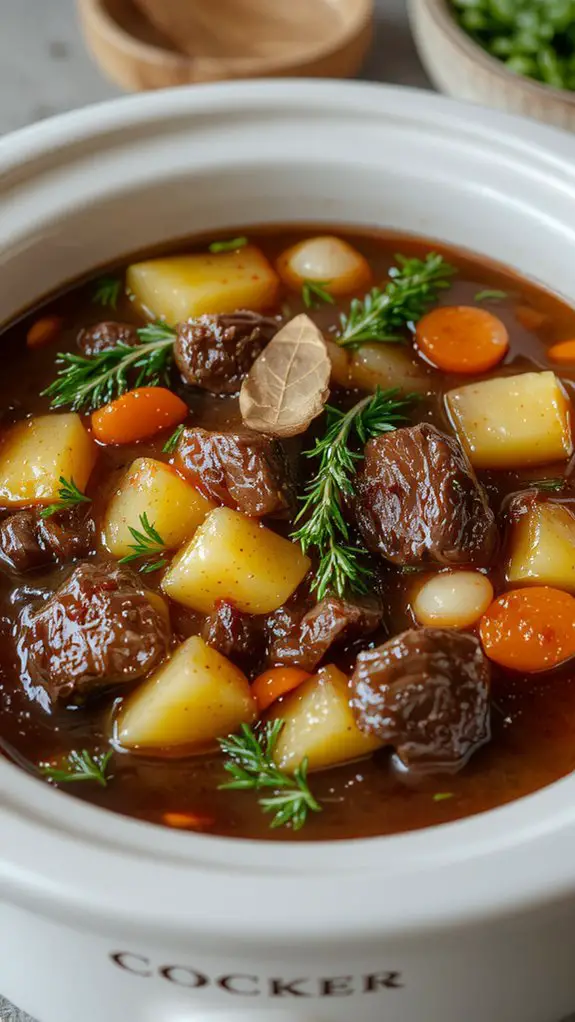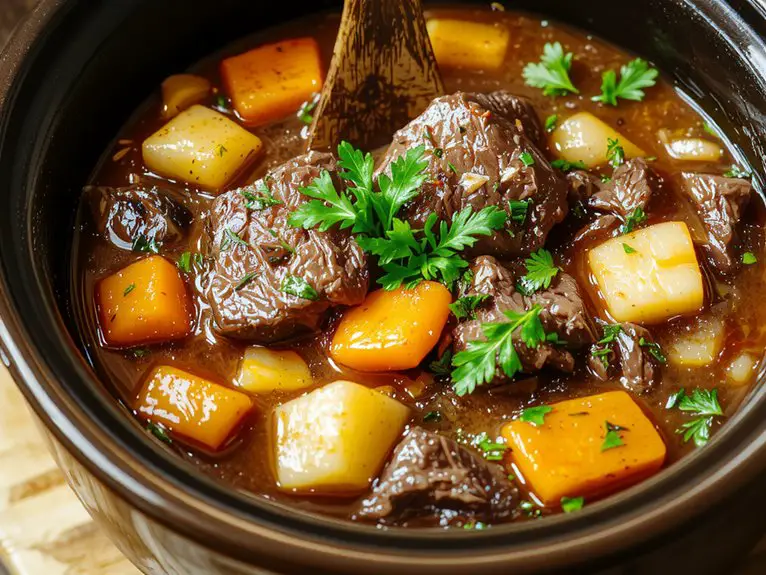I’ve spent years perfecting my slow-cooked beef stew, and this crock pot version is the one I keep coming back to. The secret lies in the balance of tender beef, rich broth, and hearty vegetables—all melding together over hours for deep, comforting flavor. If you’re looking for a foolproof way to fill your home with warmth and aroma, this recipe might just change how you think about stew forever.
Recipe
There’s nothing quite like a bowl of homemade beef stew to warm you up from the inside out—this recipe is the ultimate comfort food, and I’ll bet it’ll become your go-to on chilly nights.
What makes it special? Tender chunks of beef that melt in your mouth, slow-simmered in a rich, savory broth with carrots, potatoes, and just the right blend of herbs.
I’ve made this stew more times than I can count, tweaking it until it’s absolute perfection—thick, hearty, and packed with layers of flavor. The secret? A splash of red wine and a long, lazy simmer to let every ingredient shine.
One bite of this cozy, stick-to-your-ribs goodness, and you’ll never go back to store-bought again. Trust me, your kitchen will smell incredible, and your family will be begging for seconds.
Ingredients
The key to a rich, flavorful beef stew lies in the quality of your ingredients and a few chef-approved tricks. Opt for well-marbled beef for maximum tenderness, and don’t skimp on fresh aromatics—they’re the backbone of this hearty dish.
Here’s what you’ll need, with some flexible swaps and insider tips to make your stew unforgettable.
- Beef chuck roast (2 lbs): Cut into 1-inch cubes. Chuck roast is ideal because it’s marbled with fat, which breaks down into melt-in-your-mouth goodness during slow cooking. If unavailable, use brisket or stew meat, but avoid lean cuts.
- Olive oil (3 tbsp): For searing the beef. Look for extra virgin for the best flavor, but any neutral oil works.
- Onion (1 large, diced): Adds sweetness and depth. Yellow or white onions are perfect here.
- Garlic (4 cloves, minced): Non-negotiable for its aromatic punch. Pre-minced jarred garlic is a fine time-saver if needed.
- Carrots (3 large, sliced): Go for fresh, chunky cuts—they’ll hold up better during cooking than baby carrots.
- Celery (3 stalks, sliced): Adds a subtle earthy flavor. No celery? Skip it, but don’t skip the carrots!
- Potatoes (2 large, cubed): Use Yukon Gold or russet for creamy texture. Sweet potatoes are a fun twist if you’re feeling adventurous.
- Tomato paste (2 tbsp): A must for richness and umami. Double this if you love a deeper flavor.
- Beef broth (4 cups): Homemade or high-quality store-bought is key. Chicken or vegetable broth works in a pinch.
- Red wine (1 cup): Adds complexity—go for a dry variety like Cabernet Sauvignon. No wine? Use extra broth and a splash of balsamic vinegar.
- Bay leaves (2): Essential for that classic stew aroma.
- Fresh thyme (1 tbsp) or dried thyme (1 tsp): Fresh is best, but dried works if that’s what you have.
- Worcestershire sauce (1 tbsp): A secret flavor booster. If you don’t have it, soy sauce or fish sauce can sub in.
- Salt and pepper (to taste): Season generously, especially the beef before searing.
- Flour (¼ cup): For thickening. Cornstarch works as a gluten-free alternative.
- Optional: Frozen peas (1 cup) or fresh parsley for a pop of color and freshness at the end.
How to Make the Best Slow-Cooked Beef Stew Perfection

- Brown the beef chunks in batches using a heavy-bottomed pot or Dutch oven. Sear each piece on all sides until deeply caramelized. This adds rich flavor to the stew—don’t rush this step! Pro tip: Pat the beef dry with paper towels first for a better sear.
- Sauté the aromatics by adding onions, garlic, and carrots to the pot. Cook until softened and slightly browned, scraping up any browned bits from the beef. This builds layers of flavor.
- Deglaze with wine or broth, pouring in enough liquid to loosen the fond (those flavorful bits stuck to the pot). Stir well to incorporate. This step guarantees no flavor is left behind.
- Add the main ingredients—beef, potatoes, celery, and bay leaves—to the pot. Pour in enough broth or water to just cover the ingredients. Pro tip: Use low-sodium broth to control seasoning.
- Season generously with salt, pepper, and herbs like thyme or rosemary. Stir to combine, then bring to a gentle simmer. Taste and adjust seasoning as needed—undersalting now means bland stew later.
- Cover and simmer on low heat for 2-3 hours, stirring occasionally. The stew is done when the beef is tender and the sauce is thickened. Watch out: Avoid boiling, as it can toughen the meat.
- Add finishing touches like peas or parsley during the last 10 minutes of cooking. This keeps them vibrant and fresh.
- Let it rest for 10-15 minutes before serving. Stews taste even better the next day as flavors meld. Pro tip: Skim excess fat off the top if desired.
Nutrition
This beef stew recipe is packed with wholesome ingredients that provide essential nutrients. Below is the nutritional breakdown per serving.
| Nutrient | Amount |
|---|---|
| Calories | 350 kcal |
| Protein | 28 g |
| Carbohydrates | 25 g |
| Fat | 15 g |
| Fiber | 4 g |
| Sugar | 6 g |
| Sodium | 800 mg |
Chef Tips
When making this beef stew, I always recommend browning the meat first—it locks in flavor and gives the dish a richer depth.
Don’t skip deglazing the pot with broth or wine; it adds complexity.
Cut veggies uniformly for even cooking.
Season in layers, tasting as you go.
Low and slow cooking tenderizes tougher cuts.
Let it rest 10 minutes before serving to let flavors meld perfectly.






